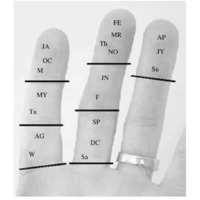-
Title
-
Japanese Hand Calculator
-
Description
-
Nakahara (1996) describes a visualization technique used by Japanese students to compute the day of the week of any day in the year. Exams sometimes contain questions requiring the student to make such a computation. The problem to be solved here concerns the coordination of the weekly cycle of seven day names with the monthly cycles of 28 (29in the case of a leap year), 30, or 31 days. The computation is accomplished by mapping the cycle of day names and the cycle of month names onto a common structure. A variety of structures might serve this purpose, but the one chosen by Japanese students is a set of regions on the first three fingers of the left hand. The regions are defined by the creases in the fingers that appear at the finger joints. These creases are imagined to make three boxes on each finger. Attending selectively to the first two fingers and the top box on the ring finger creates a field of seven boxes (see Fig. 5). The mapping of month names onto these boxes is invariant. However, the sequence of month names follows a complex trajectory across the seven boxes. It is difficult to visualize this trajector. To make the task of constructing the trajector, and the sequence of month names easier, the mapping is taught as a sequence of motions of the left thumb over the regions of the fingers. This permits the memory for the trajectory to be redundantly stored in visual and in motor memory. Since the week is seven days long, in any month all of the days that have numbers that are 0 modulo 7 will fall on the same day of the week. For example, in 2002, the 7th, the 14th, the 21st, and the 28th of August all fall on a Wednesday.
The names of the days of the week can be mapped onto the same structure using the top- to-bottom and left-to-right pattern shown. The trajector that constructs the sequence of names of days of the week (top to bottom, left to right) is less complex than the pattern of month names. It is remembered as a visual pattern only.
The intersection of this pattern of mapping day names with the pattern for mapping month names produces a complete set of correspondences between day names and month names that captures the effect of the varying lengths of months. The figure shows the arrangement for 2002. The correspondences of day names and month names change from year to year. To determine the day of the week of an arbitrary date in 2002, say August 23, one simply looks at the hand – while imagining the month and day names – and finds the box containing the month name. The day name in that box is ‘‘Wednesday’’. This means that all of the Wednesdays in August of 2002 fall on dates that are 0 modulo 7. Thus, the 7th, the 14th, the 21st, and the 28th of August are Wednesdays. Imagine the 21st of August.
-
Designer
-
Edwin Hutchins
-
Date
-
28 June 2004
-
Source
-
Material Anchors for Conceptual Blends
-
Bibliographic Citation
-
Hutchins, E. (2005). Material anchors for conceptual blends. Journal of Pragmatics, 37(10), 1555–1577. https://doi.org/10.1016/j.pragma.2004.06.008. Page 1566. Figure 5.
-
depict things of type
-
Sequence or Process
 Japanese Hand Calendar
Japanese Hand Calendar